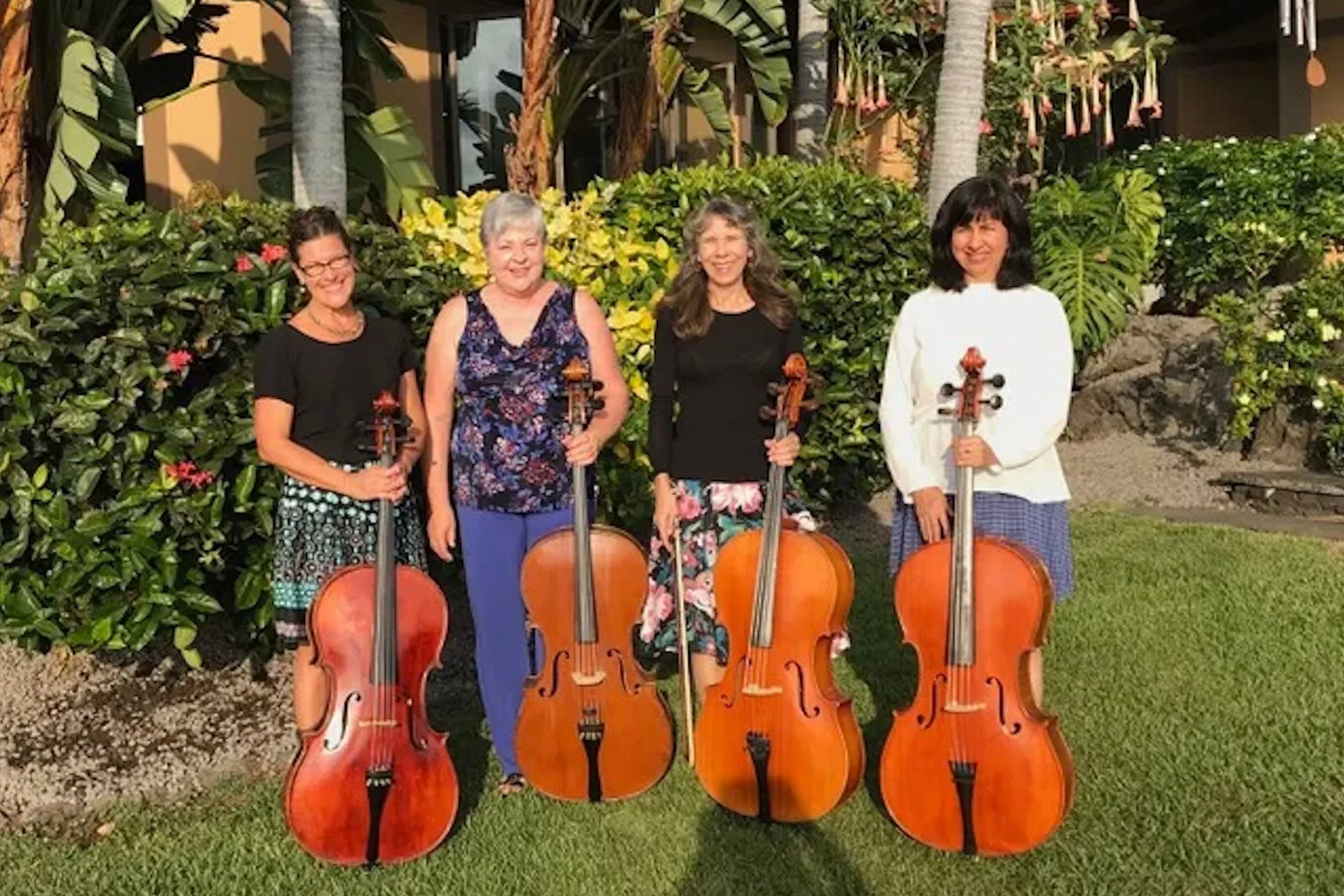Staccato Spotlight: Gigging Chamber Musicians
The summer months bring chamber musicians out to parks, wedding venues, city sidewalks, restaurant patios and more. ArrangeMe community members are among the world’s most talented arrangers and composers, and many are also performers!
In this edition of Staccato Spotlight, we highlight four arrangers who actively gig with their chamber ensembles:
Martin Ash is a London-based violist for Flux Ensemble, a string quartet.
Aaron Hettinga is a trombonist and multi-instrumentalist based in Grand Rapids, Michigan.
Kathy Fraser is an orchestral musician in Waikoloa, Hawaii who also plays in Cella Bella, a cello quartet.
Stephen Jenkins is a trombone player from Germany who plays in BlechMafia Nürnberg, a brass quintet.
How does your role as a gigging musician inform your arranging process?
Stephen: I mainly write for BlechMafia Nürnberg, and a large part of our programs are composed or arranged by our trumpeter Matthias or myself. I also write for a Church Brass Ensemble, which I also direct. This group is much harder to write for, as it is harder to write something that sounds good and is playable for amateur musicians than it is for professionals. I have also just started to work on my first wind band piece with the community band that I also conduct.
Playing with or conducting an ensemble increases your understanding of the group immensely. This knowledge is very helpful in knowing not only what is possible, but also what is practical. Playing and performing a piece always gives me the chance to make sure that the piece not only sounds good, but also plays well. That means a quality product when I publish it. The computer is a great tool for writing, but it is not always realistic when it comes to playing the piece.
BlechMafia Nürnberg trumpeter Matthias Eckart (second from left) and trombonist Stephen Jenkins (third from left) are both ArrangeMe self-publishers.
Kathy: I consider playability and overall sound. I try to make arrangements easy enough to perform on short notice, while offering an area of interest for each player. Prior to publishing on ArrangeMe, each piece is beta-tested with other musicians. Audio clips are provided, as well as videos of the cello duets. I have recently found ArrangeMe’s Blog to be a valuable resource for improving my own arrangement process.
Flux Ensemble plays at a wedding, a typical gig for Martin’s string quartet. Photo by cellist Natalie Morgan.
Martin: I arrange songs that have been requested by a client, and that we can't easily get ahold of in the right instrumentation. So really my arranging is a product of me being an ensemble manager (leading from the viola chair!). I write what I think will be more or less sightread-able, sound effective, work readily on the instruments (even if I don't always understand cello fingering) and be interesting to listen to if anyone has ended up on their own and is really listening for those 5 minutes!
Aaron: In my role as a gigging musician, I'm right there in the trenches with nowhere to hide. Whenever one of my arrangements is up on the music stands, it's nobody's fault but mine if it doesn't sound good. As a publisher/arranger I know it's not to anyone's benefit if anything is unclear on the page, so I take extra care to ensure musicians receive parts that look great from the start. Well-prepared parts will play down much better for players the first time around without any need to go back and pencil in extra clarifications, so the time spent making things “camera ready” has saved countless hours of valuable rehearsal and session time.
“In my role as a gigging musician, I’m right there in the trenches with nowhere to hide. Whenever one of my arrangements is up on the music stands, it’s nobody’s fault but mine if it doesn’t sound good. ”
What has been your greatest ArrangeMe success so far?
Kathy: The greatest reward is hearing from musicians who have performed my arrangements and original compositions in public. I was thrilled when a cello instructor from Germany informed me that his students selected my composition, “Synchromonius (The Circus Tango),” for a youth competition. Nothing compares to the joy that brings me.
Stephen’s most successful arrangement, "What a Wonderful World,” performed by his group BlechMafia Nürnberg.
Stephen: My most successful arrangement to date has been "What a Wonderful World" for brass quintet, which explores the many colors that this ensemble can achieve.
My most successful composition has been "A Charleston Love Story.” My wife loves Charleston music, so I wrote this piece for her as a wedding present. It must be good, her leg always starts swinging when we play it!
Aaron’s arrangement of “A Taste of Honey” is one of his best-selling titles.
Aaron: My greatest success from ArrangeMe is that it has allowed for significant expansion of my publishing ventures. Within a year's time, I went from offering only a couple dozen public domain and original works on my own website, blooming into a much broader marketing reach with the added benefit of incorporating arrangements of contemporary/copyrighted works. Instead of feebly pointing at my website trying to convince people that "I really am an arranger, you know...," I now have a solid showcase of hundreds of works featuring a broad range of ensembles, and many more are still on the way.
What is your favorite ArrangeMe chart that is not your own?
Aaron: My favorite chart on ArrangeMe (not my own) has to be Steve Wiest's arrangement of "Cheek to Cheek" for trombone soloist with big band. It was the lead-off track from his first solo album and that version has been stuck in my head for nearly two decades now! Steve has recently been starting to post his charts to ArrangeMe and I hope it's a great experience for him!
Martin’s Flux Ensemble plays “Uptown Funk,” arranged by Allison Gillies (quartetpad.com).
Martin: Quartetpad's (Alison Gillies) quartet arrangement of “Uptown Funk.” Great song and a lot of fun to play, with interest shared cleverly between the players and the instruments used effectively. We like to use it as a lively set closer.
Stephen: I love the stuff Seb Skelly does. The BlechMafia also played an arrangement of “Watermelon Man” from Thomas Graf and that was a pretty good chart, too.
Kathy (second from right) poses with her cello quartet, Cella Bella.
Kathy: Our quartet’s music books are graced with several arrangements by David Burndrett. While everything he composes is fun to play and makes us sound good, his “Pachelbel Rocks!” for cello quartet is the “coffee” that gets us going!
What is your advice to composers and arrangers who want to write for your ensemble type?
Martin: Remember the sounds change over different pitches—you can get a lot of variety by putting tunes in a higher violin register, or in the viola or cello with accompanying lines higher than the melody. And do put dynamic contrasts/changes in, it will make for a much more compelling performance!
Stephen’s group BlechMafia Nürnberg plays his newest chart, “Funk To Go.”
Stephen: Consider the quintet as a quartet. This allows different players to have a rest during the piece, which is very important when playing a two hour concert. Then use all 5 instruments together where needed or for various climaxes throughout the piece. We also have a percussionist in our 6-piece quintet, which allows all sorts of extra possibilities and colors as an extension of what is already available.
To create a video sample of her cello duets, Kathy plays the Cello 1 part with a recording of the Cello 2 part. “Shenandoah” is one of her best-selling arrangements.
Kathy: We look for pieces that are easy to read and ready to perform with minimal rehearsal time. Our skill sets are similar, so we all appreciate a part with movement and variety, whether we have the melody or a supporting role. Including an audio clip is a must.
Aaron: Whether arranging for big band, brass quintet, cover band horn section, or any ensemble at all for that matter, my best advice for other composers and arrangers is to listen. A lot. Listen critically both to recordings and to live performances, being very mindful of what role every instrument is playing against the others around it. Whenever I hear something that piques my interest, I can't help but dig in to gain the understanding of why it grabbed my attention because then I can assimilate that new texture/harmony/voicing knowledge into my toolbox for future use.
Learn more about these ArrangeMe members!
Martin Ash: martinashmusic.com. Follow @martinashmusic on Facebook, Instagram, and YouTube. His quartet, Flux Ensemble, can be found at fluxensemble.com and on Facebook, Instagram, and YouTube.
Kathy Fraser: kathyfraser.org and YouTube.
Aaron Hettinga: aaronhettinga.com and YouTube.
Stephen Jenkins: @trombology on Instagram and YouTube. His brass quintet, BlechMafia Nürnberg, can be found at blechmafia.de.




